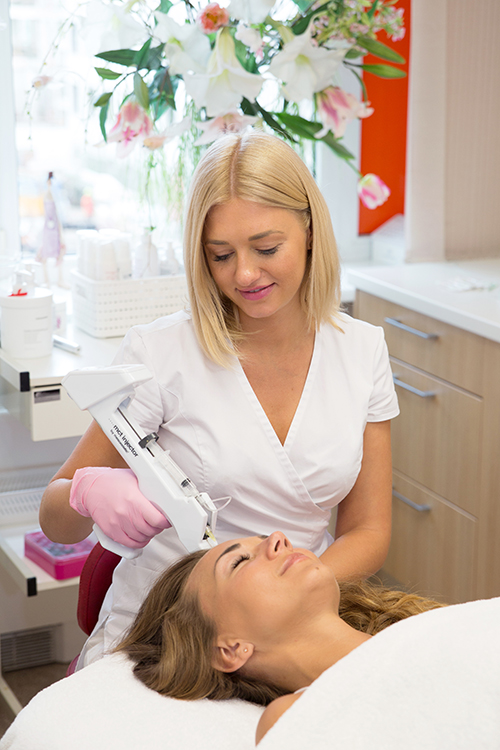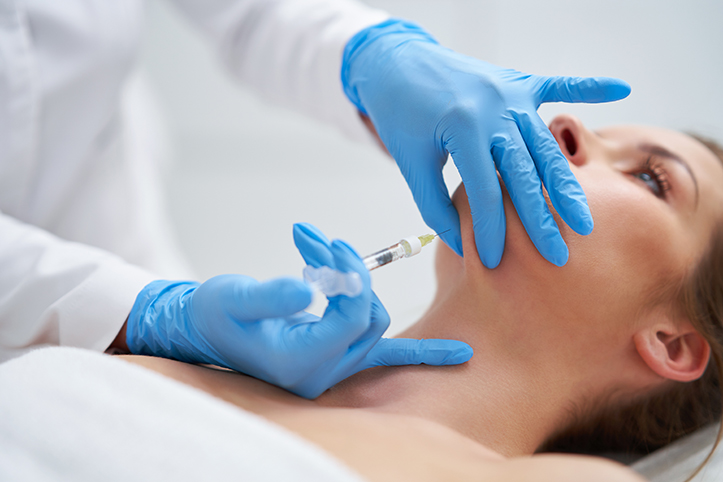Aesthetic injections (beauty injections)
Mesotherapy
Mesotherapy is an injection procedure in which individually tailored active substances are injected into the skin to improve the condition and appearance of the skin. The composition of the injected product (vitamins, trace elements, amino acids, etc.) is individual and is determined by the specialist depending on the client's needs. Mesotherapy has a deeper (up to 2 cm) and more intense effect than conventional facial treatments.
Mesotherapy:
- reduces wrinkles and other signs of ageing;
- strengthens the facial oval, neck and décolleté area;
- improves skin texture;
- reduces swelling.
Mesotherapy is not only performed on the face, but also on other areas of the body (anti-cellulite, fat-dissolving, skin tone)
Mesotherapy at the Dermatology Clinic is performed with the Mesoestetic Meso Injector, which is a painless way of injecting the product into the skin.
Mesotherapy is a painless procedure and does not interfere with your daily routine. On the first day after the procedure, you may see some needle marks.
Biorevitalisation
Biorevitalisation is an injection procedure in which hyaluronic acid is injected into the skin.
Biorevitalisation:
- restores the skin's moisture balance;
- reduces the first signs of ageing (wrinkles, loss of tone);
- stimulates the synthesis of collagen, elastin and hyaluronic acid.
Biorevitalisation is recommended after a drastic change in climate (e.g. hot summer, holiday in exotic countries) to reduce or delay the first signs of ageing - fine lines, loss of tone. Injections can also be given in the female intimate area to reduce vaginal dryness and restore elasticity and sensitivity.
Plasma injections: PRF and PRP injections for skin rejuvenation and tissue regeneration
The specialists at the Dermatology Clinic use a world-renowned method to improve wound healing, promote skin regeneration and regenerate tissue - PRP and PRF injections. During the procedure, a small amount of blood is drawn from the patient, which is placed in a special apparatus and transformed (centrifuged), thus extracting healing components from the blood.
I-PRF and PRP therapy are used depending on the indication:
- to reduce wrinkles and roughness of the skin;
- for anti-ageing therapy;
- to improve the condition of weak-textured, limp hair;
- for both dry and oily skin;
- to improve the condition of the facial skin in acne scars;
- for cellulite treatment and stretch mark reduction;
- to improve the skin's ability to regenerate after deep exfoliation, trauma, burns, etc;
- in aesthetic gynaecology.
Key benefits of PRF and PRP injections:
- safety - the substance administered is made from the patient's own blood;
- no risk of allergies or infections;
- minimal discomfort during the procedure, as it is performed with a nano-needle that causes virtually no pain.
PRF injections
Injected Platelet Rich Fibrin, or I-PRF, is a special blood structure - fibrin - extracted from the patient's own blood. The
cells that make up I-PRF - platelets, leucocytes, lymphocytes, monocytes, neutrophils and stem cells (from the peripheral circulation) - are concentrated on the fibrin matrix, which has a gelatinous consistency. The fibrin matrix releases a blood cell growth factor concentrate in a steady, cascading manner, which stimulates collagen synthesis and haemopoiesis over a period of two weeks.
I-PRF can be injected into the forehead, upper or lower eyelids, cheeks, nasolabial fold, lips and chin.
After the I-PRF treatment, the first changes are noticeable within a few weeks, the maximum effect is reached after about two months.
PRP injections
Platelet Rich Plasma (PRP) injections are based on the stimulation of cell growth and renewal thanks to the elements in platelets. Growth factors are released from the platelets by centrifugation. Platelet-rich growth factor (PRGF) is separated from the platelet-rich plasma with the help of special preparations.
The restorative effect of PRP injections is immediate and continues to improve. The results of the procedure last for several months up to a year.
Lipolytic injections - lipolytics - for fat reduction in problem areas
Lipolytic injections are used to remove local fat deposits or unwanted fat pads. This method has been used worldwide for about 20 years.
Lipolytic injection therapy is not suitable for reducing excess weight, but for removing troublesome fat "padding" in certain areas such as under the chin, in the armpits, on the thighs and elsewhere.
This type of fat deposits is usually quite difficult to get rid of, e.g. through sports, massages and other means.
The lipolytic agent dissolves the fatty cell membrane. This helps the body's lymphatic system to break down the fatty acids contained in the cells, causing the fat cells to be permanently destroyed and eliminated from the body naturally. Since fat cells do not take part in the processes of renewal and division, the results of lipolytic injections will be long-lasting.
The product is injected directly into the problem area with fine needles, without affecting the surrounding tissue. The active substance used in the injectable preparation is natural and is produced in the body in the same formulation as it is in the preparation. The circumference of the body in the injection area is reduced and the skin shrinks again thanks to its elasticity.
 Lipolytic injections are most commonly performed in the following areas:
Lipolytic injections are most commonly performed in the following areas:
- cheek area;
- submental area;
- abdomen;
- armpit, chest area;
- upper limbs;
- buttocks;
- flanks;
- back;
- thighs.
These injections are also used to treat lipomas and cellulite.
How does the lipolytic injection procedure work?
The procedure takes about 15 minutes. The lipolytic injections are administered in the specific area selected. Temporary swelling, redness and itching may occur after the procedure. The treatment area may be slightly sensitive for a few weeks after the injections. Avoid massage, sauna and sports for about three days.
How many procedures are needed?
On average, a course of lipolytic injections consists of 3-6 treatments with 5 weeks interval. The number of treatments is individually tailored to each client.
Are there contraindications?
As with all procedures, injections of lipolytic agents have certain contraindications:
- allergy to the ingredients in the preparation;
- oncological diseases;
- liver, kidney, endocrine diseases;
- diabetes;
- autoimmune diseases;
- pregnancy;
- breastfeeding.
